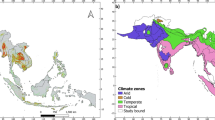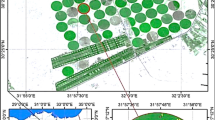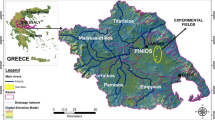Abstract
Understanding of crop water productivity (WP) over large scale, e.g., river basin, has significant implications for sustainable basin development planning. This paper presents a simplified approach to combine remote sensing, census and weather data to analyze basin rice and wheat WP in Indo-Gangetic River Basin, South Asia. A crop dominance map is synthesized from ground truth data and three existing LULC maps. National statistics on crop area and production information are collected and the yield is interpolated to pixel level using moderate resolution imaging spectroradiometer (MODIS) normalized difference vegetation index (NDVI). Crop evapotranspiration is mapped using simplified surface energy balance (SSEB) model with MODIS land surface temperature products and meteorological data collected from 56 weather stations. The average ET by rice and wheat is 368 mm and 210 mm respectively, accounting for only 69% and 65% of potential ET, and 67% and 338% of rainfall of the crop growth period measured from Tropical Rainfall Measurement Mission (TRMM). Average WP for rice and wheat is 0.84 and 1.36 kg/m3 respectively. WP variability generally follows the same trend as shown by crop yield disregarding climate and topography changes. Sum of rice-wheat water productivity, however, exhibits different variability leading to better understanding of irrigation water management as wheat heavily relies on irrigation. Causes for variations and scope for improvement are also analyzed.
Similar content being viewed by others
References
Molden D, Frenken K, Barker R, et al. Trends in water and agricultural development. In: Molden D. Water for Food, Water for Life: A Comprehensive Assessment of Water Management in Agriculture. London: Earthscan, 2007. 57–89
Rosegrant M W, Ringler C, Gerpacio R V. Water and land resources and global food supply. In: 23rd International Conference of Agricultural Economists on Food Security, Diversification, and Resource Management: Refocusing the Role of Agriculture. Sacramento: Dartmouth Publishing Co. Ltd., 1999
Molden D, Murray-Rust H, Sakthivadivel R, et al. A water-productivity framework for understanding and action. In: Kijne J W, Barker R, Molden D. Water Productivity in Agriculture: Limits and Opportunities for Improvement. Wallingford: CAB International, 2003. 1–18
Schmugge T J, Kustas W P, Ritchie J C, et al. Remote sensing in hydrology. Adv Water Resour, 2002, 25(8–12): 1367–1385
Yang P, Wu W, Zhou Q, et al. Research progress in crop yield estimation models based on spectral reflectance data (in Chinese). Trans CSAE, 2008, 24(10): 262–268
Courault D, Seguin B, Olioso A. Review on estimation of evapotranspi ration from remote sensing data: From empirical to numerical modeling approaches. Irrig Drain Syst, 2005, 19(3): 223–249
Moulin S, Bondeau A, Delecolle R. Combining agricultural crop models and satellite observations: From field to regional scales. Int J Remote Sens, 1998, 19(6): 1021–1036
Frolking S, Qiu J, Boles S, et al. Combining remote sensing and ground census data to develop new maps of the distribution of rice agriculture in China. Glob biogeochem Cycles, 2002, 16(4): 1–10
Frolking S, Xiao X, Zhuang Y, et al. Agricultural land-use in China: A comparison of area estimates from ground-based census and satellite-borne remote sensing. Glob Ecol Biogeogr, 1994, 8(5): 407–416
McCoy R M. Field Methods in Remote Sensing. New York: Guilford Press, 2004. 159
Harvey J T. Estimating census district populations from satellite imagery: Some approaches and limitations. Int J Remote Sens, 2002, 23(10): 2071–2095
Sutton P, Roberts D, Elvidge C, et al. Census from heaven: An estimate of the global human population using nighttime satellite imagery. Int J Remote Sens, 2001, 22(16): 3061–3076
Hurtt G C, Rosentrater L, Frolking S, et al. Linking remote-sensing estimates of land cover and census statistics on land use to produce maps of land use of the conterminous United States. Glob Biogeochem Cycles, 2001, 15(3): 673–685
Mesev V. The use of census data in urban image classification. Photogramm Eng Remote Sens, 1998, 64(5): 431–438
Neto E R, Hamburger D S. Census data mining for land use classification. In: Cao L, Yu P S, Zhang C, et al. Data Mining for Business Applications. New York: Springer, 2009. 241–251
Rindfuss R R, Stern P C. Linking remote sensing and social science: The need and the challenges. In: Liverman D, Moran E F, Rindfuss R R, et al. People and Pixels: Linking Remote Sensing and Social Science. Washington: National Academy Press, 1998. 1–27
Shah T, Singh O P, Mukherji A. Groundwater irrigation and South Asian agriculture: Empirical analysis from a large scale survey of India, Pakistan, Nepal and Bangladesh. Hydrogeology J, 2006, 14(3): 286–309
Ullah M K, Habib Z, Muhammad S. Spatial Distribution of Reference and Potential Evapotranspiration across the Indus Basin Irrigation Systems. Technical Report, International Water Management Institute, Lahore, Pakistan, Working Paper 24. 2001
Loveland T R, Reed B C, Brown J F, et al. Development of a global land cover characteristics database and IGBP DISCover from 1 km AVHRR data. Int J Remote Sens, 2000, 21(6–7): 1303–1330
Thenkabail P S, Biradar C M, Turral H, et al. An Irrigated Area Map of the World (1999) Derived from Remote Sensing. Technical Report, International Water Management Institute, Colombo, Sri Lanka, Research Report 105. 2006
Xiao X, Boles S, Frolking S, et al. Mapping paddy rice agriculture in South and Southeast Asia using multi-temporal MODIS images. Remote Sens Environ 2006, 100(1): 95–113
Thenkabail P S, Gangadhararao P, Biggs T, et al. Spectral matching techniques to determine historical land use/land cover (LULC) and irrigated areas using time-series AVHRR pathfinder datasets in the Krishna River Basin, India. Photogramm Eng Remote Sens, 2007, 73(9): 1029–1040
Cai X L, Sharma B. A regional crop dominance map based on remote sensing, census and groundtruth data. In: International Conference on Food Security and Environmental Sustainability. Kharagpur: Indian Institute of Technology, 2009
Bastiaanssen W G M, Thiruvengadachari T, Sakthivadivel R, et al. Satellite remote sensing for estimating productivities of land and water. Int J Water Resour Dev, 1999, 15(1–2): 181–196
Senay B G, Budde M, Verdin J P, et al. A coupled remote sensing and simplified surface energy balance approach to estimate actual evapotranspiration from irrigated fields. Sensors, 2007, 7(6): 979–1000
Author information
Authors and Affiliations
Corresponding author
Rights and permissions
About this article
Cite this article
Cai, X., Sharma, B. Remote sensing and census based assessment and scope for improvement of rice and wheat water productivity in the Indo-Gangetic Basin. Sci. China Ser. E-Technol. Sci. 52, 3300–3308 (2009). https://doi.org/10.1007/s11431-009-0346-3
Received:
Accepted:
Published:
Issue Date:
DOI: https://doi.org/10.1007/s11431-009-0346-3




